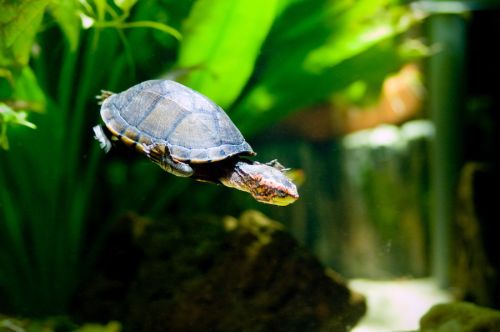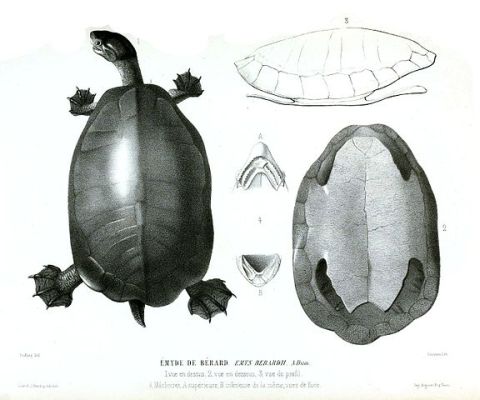
| Palaeos |  |
Chelonii |
| Vertebrates | Kinosternoidea |
| Page Back | Unit Home | Unit Dendrogram | Unit References | Taxon Index | Page Next |
| Unit Back | Vertebrates Home | Vertebrate Dendrograms | Vertebrate References | Glossary | Unit Next |
|
Abbreviated Dendrogram
ANAPSIDA ? | o CHELONII |--Odontochelys `--+--Proganochelys `--+--Proterochersis `--+--Pleurodira |--Paracryptodira `--+--Protostegidae `--+==Xinjiangchelyidae `--o Centrocryptodira |==Sinemydidae |--Trionychoidea `--+--+--Chelonioidea | `--+--Chelydridae | |--Emarginachelys | `--o Kinosternoidea | |--Dermatemydidae | `--o Kinosternia | |--Agomphus | |--Hoplochelys | `--o Kinosternidae | |--Kinosterninae | `--Staurotypinae `--Testudinoidea |
Contents
Overview |
Taxa on This Page
Phylogeny: Chelonioidea-Chelydridae-Kinosternoidea clade : Panchelonioidea + (Chelydridae + Kinosternoidea + * )
Range: Late Cretaceous of NA (Maastrichtian of Montana)
Comments: Despite being known from good fossil material, this Cretaceous form is difficult to place phylogenetically. It has been included under the Chelydridae (Carroll 1988, p.616), as a sister taxon to the Kinosternoidea (Joyce 2007), and as sister taxon to a clade uniting Kinosternoidea, Trionychoidea, Testudinoidea, with (Kinosternoidea + Trionychoidea + Testudinoidea) + Emarginachelys being the sister clade of Chelydridae (Sterli 2010 fig 1). Until something better comes along we are following Joyce's 2007 study and tentatively placing Emarginachelys as stem-Kinosternoidea. Another interpretation could be as part of an unresolved trichotomy in the molecular phylogeny clade uniting Chelydridae and Kinosternoidea MAK130306
 |
| Kinosternon cruentatum, photograph by Zippo Zimmermann. via CKT |
Range: From the Late Cretaceous
Phylogeny: Chelonioidea-Chelydridae-Kinosternoidea clade : Panchelonioidea + (Chelydridae + Emarginachelys + * : Dermatemydidae + Kinosternia)
Characters: scale set 2 (extragulars) lost from plastron (Hutchison and Bramble, 1981); scale set 4 (pectorals) lost from plastron (Hutchison and Bramble, 1981); no scales on skull roof (Meylan & Gaffney, 1989)
Comments: According to morphological analysis the Kinosternoidea are the sister group to the Trionychoidea. Molecular sequencing however places them with the Chelydridae and Chelonioidea, slightly in closer to the former. There is better consensus regarding the sister group relationship between the Dermatemydids and Kinosternids, which is strong supported by both morphological and molecular data. Corresponds to Kinosternoidae of Gaffney & Meylan 1988 and the Pankinosternoidea of Joyce et al 2004 p.1003). MAK130306
 |
| Dermatemys mawii, drawing from Archive du Museum D'Histoire Naturelle. Tome 6, Public Domain, via Wikipedia |
Dermatemydidae Baptemys, Dermatemys (= Pandermatemys)
Range: Late Cretaceous or Eocene to Recent
Phylogeny: Kinosternoidea : Kinosternia + *
Characters: commissural ridge on triturating surface; foramen stapedio-temporalis closed; axillary buttresses reach costal bones (Meylan & Gaffney, 1989)
Comments: Represented today only by the now rare and critically endangered Central American river turtle Dermatemys mawii. This is a a nocturnal, aquatic species that lives in larger rivers and lakes in Central America, from southern Mexico to northern Honduras. Dermatemys is a fairly large turtle, attaining a maximum size of 65 cm in carapace length, and weight up to 22 kg ( Wikipedia). Various fossil forms, including the Adocids (now placed in the Trionychoidae), have been assigned to or related to the Dermatemydidae, with Dermatemydids proper dating back to Cretaceous. The tendency among current, cladistic, workers is to reject earlier taxa based only on plesiomorphic (shared primitive) characters. This is not to say that some of these Cretaceous forms might not be ancestral or stem dermatemydids, only that there status cannot be verified. Some fossil species included in the Dermatemydidae may be placed in the phylogenetic stem of Kinosternoidea. Currently only Baptemys from the Eocene of North American is included among the early fossil forms; with the well-known type species Baptemys wyomingensis used in cladistic analysis (Joyce et al 2004 p.1003)
Range: From the Late Cretaceous
Phylogeny: Kinosternoidea : Dermatemydidae + * : Agomphus + Hoplochelys + Kinosternidae)
Characters: no more than three inframarginal scales present on each bridge (occurs also in Basilemys) (Meylan & Gaffney, 1989)
Comments: Includes Kinosternidae and several basal forms (Gaffney and Meylan, 1988; Joyce et al., 2004).
|
|||||
Range: Late Cretaceous to Paleocene of North America
Phylogeny: Kinosternia : Hoplochelys + Kinosternidae + *
Description: Shell thick and heavy. Free borders of the carapace thickened and obtuse. Exposed surfaces of the shell not pitted. Hinder marginal scutes not rising on the costal bones, except slightly in one species. Inframarginal scutes present. The pectoral scutes extending forward to the hinder end of the epiplastrals. Intergulars not known. Nuchal with costiform processes. Rib-heads more strongly developt than in Adocus. Hay (1908) p.248.
Comments: Previously included in the Dermatemydidae (Mlynarski 1976, p.63), Agomphus is now considered a relative of the mud turtles (Kinosternidae). This was probably a terrestrial genus. It is known only from its fossil shells, which are about 30cm long. Like true tortoises, the shell of Agomphus is oval in shape, highly domed and smooth, implying similar habits (Jehle, 2006), Like many reptile and lissamphibian taxa, it crossed the Cretaceous-Paleocene boundary without harm.
Hoplochelys crassa (Cope 1888)
Range: Paleocene
Phylogeny: Kinosternia : Agomphus + Kinosternidae + *
Description: Shell thick and solid. Peripherals united to the plastral bones by means of digitations and dentated sutures; with the costals by gomphosis and in addition by simple apposition or sutures. Carapace furnisht above with three carinas. Plastron with anterior lobe immovable and with the posterior lobe narrow. - Hay (1908) p.263,
Comments: Cope assigned this species to the genus Chelydra. Hay (1908) erected the new genus Hoplochelys and placed it in the Dermatemydidae, where it was still asigned by (Carroll 1988, p.615). Now considered a stem Kinosternid (Joyce et al 2004 p.1003)
Range: Late Cretaceous (Campanian) to Recent of North and South America
Phylogeny: Kinosternia : Agomphus + Hoplochelys + * : Kinosterninae + Staurotypinae
Characters: (from Gaffney & Meylan 1988): Ten pairs of peripherals; abdominal scales absent; no ribs connecting ninth and tenth vertebrae to eight costal; frontal not reaching orbit; maxilla contacting quadratojugal; ilio-ischial notch in acetabulum; incised anterior musk duct. CKT
Comments: The Kinosternidae of North and South America include the musk turtles, so called because of their production of a foul-smelling substance from glands under the tail when disturbed. CKT Also called mud turtles, they are slow swimmers, with a double-hinged plastron; reduced plastron in musk turtles (rely on jaws for defense) for agility, can climb trees. ref There are 25 living species and 4 extant genera, placed in two subfamilies, the Kinosterninae and Staurotypinae. The oldest known stem-fossil attributed to this group are undescribed remains from the Late Cretaceous (Campanian) of North America. Baltemys, from the Eocene, and Xenochelys from the Eocene to Oligocene (Carroll 1988, p.615), belong to the crown Kinosternidae. (Joyce et al 2004 p.1003). As both are known from North America it is likely that is the geographic origin of the group MAK130306
Range: Eocene to Recent of North and South America
Phylogeny: Kinosternidae : Staurotypinae + *
Comments: The oldest fossil forms are Baltemys staurogastros, from the Eocene, and Xenochelys formosa Hay 1906 from the Oligocene of South Dakota (considered Staurotypinae by Mlynarski 1976, p.68).
Range: Recent of North and Central America
Phylogeny: Kinosternidae : Agomphus + Hoplochelys + *
| Page Back | Unit Home | Page Top | Page Next |
Page last modified MAK130301. Creative Commons Attribution License Version 3.0, and may be freely used provided acknowedgement is given. All Wikipedia material is either Gnu Open Source or Creative Commons (see original Wikipedia page for details). Other graphics are copyright their respective owners